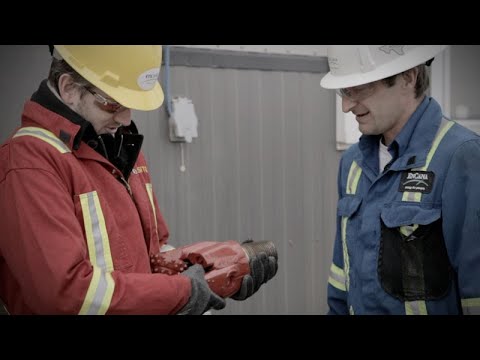Career Overview
Contractors and supervisors in oil and gas drilling services coordinate and supervise the activities of workers engaged in drilling for oil or gas, operating service rigs or providing oil and gas services.
People in this occupation:
- Work for drilling and well service contractors and petroleum producing companies
- Are the senior on-site representative for rig contractors
- Should have strong leadership, managerial, organizational, communication and mechanical skills
- Must be comfortable working both independently and in a team
- Must be quick-thinking and must have the ability to plan and direct the work of others
- Should be observant, responsible, physically fit and have knowledge of safety procedures
This group includes oilfield consultants who may be self-employed.
Job Titles
Duties
Supervisors in this unit group perform some or all of the following duties:
- Supervise, coordinate and schedule the activities of workers who drill for oil and gas, operate service rigs or provide oil and gas well services
- Establish methods to meet work schedules and coordinate work activities with other stakeholders
- Request materials and supplies
- Solve work problems and recommend ways to improve productivity
- Train workers in job duties, safety procedures and company policies
- Recommend personnel actions such as hires and promotions
- Prepare production and other reports
- May set up machines and equipment
Earnings
Earnings is income that workers receive in exchange for their labour. Depending on the type of employment, earnings can be in the form of wages (hourly), salaries (fixed monthly or annual) or self-employed earnings.
Work Environment
# Workers Employed
630% Employed Full Time
40%Supervisors in this group work around heavy machinery and equipment. A number of potential hazards exist on site relating to large, moving machinery, potentially harmful chemicals and unstable terrain. Given these conditions, workplace safety is at the forefront and all work sites follow strict safety regulations, including wearing eye protection, gloves, hard hats and steel-toed boots.
Many rig sites are located in remote areas. As a result, supervisors may be required to travel and remain on site for extended periods of time. Since work sites are located outdoors, workers may also be exposed to many different types of weather conditions.
Most supervisors in this field work full time. Part-time work is not common and only a small number of supervisors are self-employed. Rigs operate for 24 hours a day and rotating shifts of 8–12 hours are very common, with supervisors potentially working in excess of 40 hours a week. Work hours, job location and travel requirements vary with the employer and the type of job.
Career Pathways
To become a supervisor in this field, workers should gain as much experience, on-the-job training and education as possible. Supervisors may advance to management positions.
Occupational Interests
It’s important to understand what kinds of occupations align with your interests.
For more about occupational interests visit Skills for the Future Workforce > Characteristics.
Here are the top occupational interest(s) for this career profile:
Education, Training and Skills
Supervisors are required to have completed secondary school, as well as college or Energy Safety Canada courses. Other training and requirements may include:
- A two-year college diploma in petroleum engineering technology
- Certificates in first aid, hydrogen sulphide awareness, blowout prevention and well control, waste hazardous materials information system, transportation of dangerous goods or other safety and technical subjects, which are mandatory
- Considerable experience in all of the junior positions leading up to this position
The Canadian Association of Oilwell Drilling Contractors website at www.caodc.ca also provides detailed education requirements.
Education programs in B.C.

Top Skills
Every job calls for a certain set of skills. Knowing those skills is the first step in finding a good career fit.
Here, you will find the 10 most relevant workplace skills. Some are more important to achieving success in a certain career than others. These skills may come naturally to you or you may need to gain them through education, training and experience.
See the list of work-related skills below, ranked in order of importance for this career. Check out the list and see if this career matches your skills—take that first step!
Adjusting actions in relation to others' actions.
Motivating, developing and directing people as they work, and identifying the best people for the job.
Talking to others to share information effectively.
Giving full attention to what other people are saying, taking time to understand the points being made, asking questions as appropriate, and not interrupting at inappropriate times.
Managing one’s own time and the time of others.
Keeping track of and assessing your performance, other individuals, or organizations to make improvements or take corrective action.
Using logic and reasoning to identify the strengths and weaknesses of alternative solutions, conclusions or approaches to problems.
Understanding written sentences and paragraphs in work-related documents.
Considering the relative costs and benefits of potential actions to choose the most appropriate one.
Convincing others to change their mind or behaviour.
Labour Market Statistics
Discover data, facts and information that have been gathered and analyzed. Learn about the characteristics of the economy and labour market in B.C.
Employment
Find out about employment types and trends by region and industry.
Employment
630Employment by Region







| Region | Employment | % Employment of this Occupation |
|---|---|---|
| Cariboo | 20 | 3.2% |
| Kootenay | 75 | 11.9% |
| Mainland/Southwest | 55 | 8.7% |
| North Coast and Nechako | 0 | 0.0% |
| Northeast | 245 | 38.9% |
| Thompson-Okanagan | 175 | 27.8% |
| Vancouver Island/Coast | 55 | 8.7% |
Labour Market Outlook
The B.C. Labour Market Outlook is a 10-year forecast of the expected supply and demand for labour in the province. It’s usually updated every year. The purpose is to provide British Columbians with the knowledge to make informed decisions on careers, skills training, education and hiring.
Forecasted Job Openings (2025-2035)
400Forecasted Job Openings
Forecasted Employment Growth Rate
Composition of Job Openings
Job Openings by Region (2025-2035)







| Region | Job Openings | Avg. Annual Employment Growth |
|---|---|---|
| Cariboo | 20 | 0.6% |
| Kootenay | 80 | 0.3% |
| Mainland/Southwest | 20 | 0.7% |
| North Coast and Nechako | Not available | Not available |
| Northeast | 120 | 0.8% |
| Thompson-Okanagan | 120 | 1.0% |
| Vancouver Island/Coast | 30 | 0.4% |
Industry Highlights
Learn about the opportunities in B.C.'s major industries, including employment trends, earning potential, locations of work and more.
Forecasted Job Openings by Industry
| Industry | Job Openings (2025-2035) |
|---|---|
| Mining and Oil and Gas Extraction | 360 |
| Professional, Scientific and Technical Services | 20 |
| Construction | 10 |
Insights from Industry
Demand for experienced employees in this very small occupational group is expected to grow at an average rate. New job growth will be largely due to rising prices and demand for energy commodities, which prompts companies to increase their workforces to support increased production and exploration activity.
Due to the small size of this occupational group, openings that arise from job creation and retirements will be relatively few. Employees with experience in directional and horizontal drilling projects, as well as large multi-rig jobs should have an advantage in finding work.
Resources
-
Canadian Association of Oilwell Drilling Contractors (CAODC)caodc.ca
-
Canadian Institute of Mining, Metallurgy and Petroleum (CIM)www.cim.org
-
Careers in Oil + Gaswww.careersinoilandgas.com
-
Ministry of Energy and Climate Solutionswww2.gov.bc.ca/gov/content/governments/organizational-structure/ministries-organizations/ministries/energy
-
Petroleum Services Association of Canada (PSAC)www.psac.ca
-
Rig Techwww.rigtech.ca
-
SkilledTradesBCskilledtradesbc.ca/








